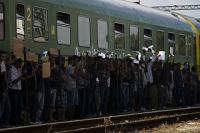-
GOP lawmakers try to block funding for Syrian refugees settlement in U.S.
Republican lawmakers in the House are drafting a bill which would block federal funding for resettling Syrian refugees in the United States until the federal government adopts a “processes to ensure that refugee and related programs are not able to be co-opted by would-be terrorists.” The draft bill also requires that the administration create a “longer-term monitoring process” to track Syrian refugees in the United States.
-
-
Growing number of states say they would not accept Syrian refugees

A growing number of states have said they would not accept Syrian refugees because of security worries in the wake of the terrorist attacks in Paris. So far, the governors of seventeen states have announced they would refuse to allow Syrian refugees to settle in their states: Alabama, Arizona, Arkansas, Florida, Georgia, Illinois, Indiana, Iowa, Louisiana, Massachusetts, Michigan, Mississippi, New Hampshire, North Carolina, Ohio, Texas, and Wisconsin.
-
-
France demands effective suspension of the Schengen open borders agreement
France will this week call for an effective suspension of the Schengen Agreement on open borders across Europe. The agreement was in 1985 in the town of Schengen in Luxembourg. It removes border checks within Europe, meaning that anyone. France will not call for a formal abrogation of the agreement, but would rather demand that all members of the Schengen Zone begin border identity checks, a move which amount to an effective suspension of the 30-year old agreement
-
-
France attacks ISIS targets in Raqqa, says more retaliatory actions will follow
French warplanes have launched thirty airstrikes on more than a dozen Islamic State targets in Raqqa, the capital of the self-proclaimed caliphate. The raids were France’s first – but likely not the last — retaliation to Friday’s terrorist attacks in Paris. The French Ministry of Defense said in a statement that the sites attacked by the French planes had previously been identified on reconnaissance flights. The bombing raids were launched simultaneously from bases in the United Arab Emirates and Jordan in coordination with U.S. forces.
-
-
U.K. put special British police unit on standby in the wake of Paris attacks
In the early hours of Saturday, following the previous evening’s terrorist attacks in Paris, the British government put a special British police unit on standby for an emergency national mobilization of officers. The move was a precautionary measure taken as the government weighed placing the United Kingdom on its highest state of terrorist alert. There are forty-three local police forces in England and Wales, and raising the terrorist threat level to critical — the highest would have triggered the dispatching of officers from some of these local forces patrol sites and neighborhood in the country’s big cities.
-
-
How Islamic law can take on ISIS
The vast majority of Muslims almost certainly feel moral revulsion and outrage about the violence perpetrated by ISIS in Paris last Friday. However, the truth of the matter is that ISIS leaders and supporters can and do draw on a wealth of scriptural and historical sources to justify their actions. Traditional interpretations of Sharia, or Islamic law, approved aggressive jihad to propagate Islam. They permitted the killing of captive enemy men. They allowed jihadis to enslave enemy women and children, as ISIS did with the Yazidi women in Syria. ISIS’ claim of Islamic legitimacy can be countered only by a viable alternative interpretation of Islamic law. But for an alternative view of Sharia to emerge and take root through modern consensus, Muslims must first acknowledge and confront the problem of having acquiesced to a traditional interpretation of Sharia and ignored alternatives that would condemn ISIS as un-Islamic. Whenever ISIS collapses or is defeated, and for whatever cause, the world can only expect a new ISIS to emerge every time one disappears until we Muslims are able to discuss openly the deadlock in reforming Sharia.
-
-
U.K. plans to boost counterterrorism, aviation security significantly

The U.K. government will substantially increase efforts to counter the threat from ISIS. In the five-year defense and security review, to be unveiled next week, the government details plans to increase the staff of MI5, MI6, and GCHQ by 1,900 officers; at least a double the funding for aviation security around the world; and deploy additional aviation security officers to assess security at overseas airports.
-
-
Updated toll : 129 dead, 352 injured – 99 in critical condition
President Francois Hollande declared three days of national mourning, beginning Monday. France will observe a moment of silence on Monday at noon. Hollande said the Friday’s terrorist attack constitute “acts of war” against France. At least one of the attackers was a French citizen: He was born on 21 November 1985 in the suburb of Courcouronnes, about twenty miles south of Paris. He had been known to police since 2004 and was flagged as an extremist in 2010. One gunman was found with a Syrian passport in his pocket, born in 1980. He had not previously been known to French police. This terrorist arrived in Greece with a group of sixty-nine Syrian refugees, and was allowed into France on 3 October. It is not known whether the terrorist is Syria, since Syrian identity documents are being bought and sold on the black market.
-
-
Terrorist attacks in Paris kill scores, hostages taken
Terrorists likely affiliated with ISIS have simultaneously attacked three targets across Paris three hours ago. French authorities say that so far there are sixty confirmed dead. One of the targets, the Bataclan concert hall, was attacked while the American rock group Eagle was performing on stage. The police say that there are about 100 people being held hostage inside the concert hall. The French government has announced a state of emergency across France, and closed the country’s borders.
-
-
“High degree of certainty” Jihadi John was killed by U.S. airstrike Thursday
The Pentagon confirmed earlier today (Friday) that a U.S. airstrike in Syria targeted Mohammed Emwazi, the ISIS terrorist known as “Jihadi John,” who appeared in several grisly ISIS propaganda videos showing the beheadings of eight hostages. U.S. military sources said there was a “99 percent certainty” that Emwazi had been killed in the drone strike. Analysts say that Mohammed Emwazi had no meaningful role in ISIS’ leadership structure, but that symbolically, his death would show that Islamic State is an organization that is suffering and that it would undercut recruitment.
-
-
U.S. new strategy: Take out ISIS-controlled oil fields in Syria
In an effort to disrupt ISIS’ main source of income, U.S. and allied forces have significantly intensified their airstrikes against the oil fields that the militant group controls in eastern Syria. ISIS’ oil production earns the about $40 million a month, or nearly $500 million a year, according to Treasury Department estimates. Military officials said that the goal of the operation over the next several weeks is to cripple eight major oil fields, about two-thirds of the refineries, and other oil-production sites controlled by ISIS, aiming to paralyze the group’s oil-production capability not for days, but for six months to a year.
-
-
Facebook: Governments’ demanding more user data, content restrictions
Facebook says that governments’ requests for information and for the removal of content have increased in the first half of 2015. Such requests have substantially increased in the last two years, since the company began releasing such information. The number of accounts for which governments around the world have requested account data jumped 18 percent in the first half of 2015, to 41,214 accounts, up from 35,051 requests in the second half of 2014.
-
-
Lawmakers want to know scope of federal agencies’ use of cellphone tracking technology
Members of the House Oversight Committee on Monday sent letters to the heads of twenty-four federal agencies asking them whether or not their agencies employ the StingRay cell phone tracking technology. The technology simulates a cell phone tower so it can collect information on mobile phones and their users. The letters are indicative of a growing unease with the unregulated use of the technology by federal agencies.
-
-
German spy agency spied on FBI, UN bodies, and German citizens: Report
BND, Germany’s intelligence service, spied on the FBI, French foreign minister Laurent Fabius, UNICEF — the UN Children’s Fund, the International Court of Justice in The Hague, and the World Health Organization, among many other targets. What may upset many Germans is the fact that the list of BND surveillance targets also included German citizens. Germany has strict privacy laws and German citizens are not allowed to be spied on without a thorough review by the courts.
-
-
NSA phone metadata collection program “likely violates constitution”: Judge
Washington, D.C. district court judge Richard Leon, ruling on Monday against the National Security Agency (NSA), said that the agency’s bulk phone metadata collection “likely violates the constitution.” Judge Leon, ruling in a case brought by conservative activist attorney Larry Klayman, said that the NSA must immediately end collecting the defendants’ information. Leon said he believed it was “substantially likely” that “the program is unlawful,” and that in that event, “the plaintiffs have suffered concrete harm traceable to the challenged program.”
-
More headlines
The long view
Factories First: Winning the Drone War Before It Starts
Wars are won by factories before they are won on the battlefield,Martin C. Feldmann writes, noting that the United States lacks the manufacturing depth for the coming drone age. Rectifying this situation “will take far more than procurement tweaks,” Feldmann writes. “It demands a national-level, wartime-scale industrial mobilization.”
No Nation Is an Island: The Dangers of Modern U.S. Isolationism
The resurgence of isolationist sentiment in American politics is understandable but misguided. While the desire to refocus on domestic renewal is justified, retreating from the world will not bring the security, prosperity, or sovereignty that its proponents promise. On the contrary, it invites instability, diminishes U.S. influence, and erodes the democratic order the U.S. helped forge.
Fragmented by Design: USAID’s Dismantling and the Future of American Foreign Aid
The Trump administration launched an aggressive restructuring of U.S. foreign aid, effectively dismantling the United States Agency for International Development (USAID). The humanitarian and geopolitical fallout of the demise of USAID includes shuttered clinics, destroyed food aid, and China’s growing influence in the global south. This new era of American soft power will determine how, and whether, the U.S. continues to lead in global development.
Water Wars: A Historic Agreement Between Mexico and US Is Ramping Up Border Tension
By Natasha Lindstaedt
As climate change drives rising temperatures and changes in rainfall, Mexico and the US are in the middle of a conflict over water, putting an additional strain on their relationship. Partly due to constant droughts, Mexico has struggled to maintain its water deliveries for much of the last 25 years, deliveries to which it is obligated by a 1944 water-sharing agreement between the two countries.
How Disastrous Was the Trump-Putin Meeting?
In Alaska, Trump got played by Putin. Therefore, Steven Pifer writes, the European leaders and Zelensky have to “diplomatically offer suggestions to walk Trump back from a position that he does not appear to understand would be bad for Ukraine, bad for Europe, and bad for American interests. And they have to do so without setting off an explosion that could disrupt U.S.-Ukrainian and U.S.-European relations—all to the delight of Putin and the Kremlin.”
How Male Grievance Fuels Radicalization and Extremist Violence
By Haily Tran
Social extremism is evolving in reach and form. While traditional racial supremacy ideologies remain, contemporary movements are now often fueled by something more personal and emotionally resonant: male grievance.
